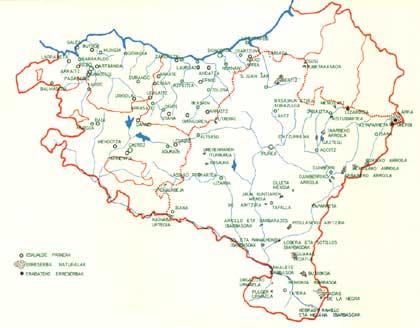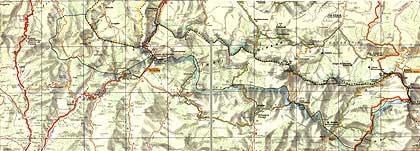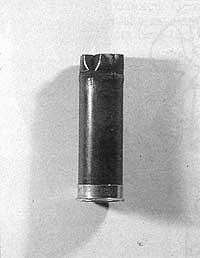Situation of nature protection in Euskal Herria
1988/02/01 Barandiaran, Mariaje | Irazabalbeitia, Inaki - kimikaria eta zientzia-dibulgatzaileaElhuyar Fundazioa Iturria: Elhuyar aldizkaria
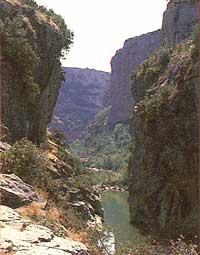
We can enjoy them. In them we can match nature and master nature. Will our children and grandchildren have the same opportunity? It is in our hands. If we deserve due respect to nature and take care of the environment, we can extend the heritage that we have in our hands, which is not ours, to our heirs.
Nature has suffered numerous attacks among us. The Basque Country is small and has a relatively high population. Consequently, human pressure on nature increases. The attack is manifested above all in the Cantabrian side. The forests have been demolished and planted with strange species, the animals have been attacked (in many cases expired), the rivers and streams are stained, the mountains have been covered with land and filled by the cause of the tracks made meaningless and the marshes and wet areas. The ancient ecosystems of Euskal Herria are altered and degraded, remaining in their original state in few places.
Educate our society on respect for nature. But that's not enough. In addition to educating society in respect of nature, we must protect it from the attacks that these unique natural spaces can suffer. This requires the development and implementation of appropriate legislation. Protected means and territories are a (not the only) way to ensure the conservation of the natural heritage of the Basques. In what situation are the protected spaces in Euskal Herria?
When analyzing the degree of protection of nature in the Basque Country, we will limit ourselves to the peninsular Basque Country since we have not been able to collect data on the North Basque Country. Despite being regrettable, many times we cannot take Euskal Herria in its entirety.
Situation in the State
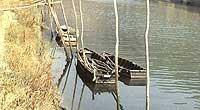
Before analyzing the situation of the protected media in the peninsular Basque Country, the possibilities of environmental protection offered by Spanish legislation are mentioned. In the State there is a wide range of laws that ensure the protection of the environment. Highlights: Law of Protected Natural Spaces, Law of Mountains, Law of River Fishing, Law of Water and Law of the Soil. The Protected Natural Spaces Act, directly linked to protection, classifies protected territories into four categories: Integral Reserves of Scientific Interest, National Parks, Natural Sites of National Interest and Natural Parks.
Let's analyze each of these levels.
The highest level of protection corresponds to the Total Reserves of Scientific Interest. Typically, large surface areas are not of great scientific interest. These protected environments are limited to scientific research. Its objective is double. On the one hand, it is about protecting, preserving and completely improving these means and, on the other, avoiding actions that involve their modification, disruption, deterioration and transformation. There are no places of this level in the Basque Country, although the Total Reserves referred to in the legislation published by the Government of Navarra are very similar. In this category is the Doñana National Park Biological Reserve.
The National Parks, for their part, are implanted in territories of great extension and its main objective is to protect the ecosystems that have not yet been touched by man so that they remain in them. They are usually in a very nice place. There is no national park in the Basque Country, but many visit the Ordesa de Huesca.
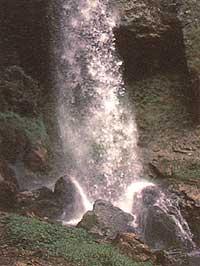
The Natural Sites are, on the other hand, areas of special interest with a reduced area.
Finally, the Natural Parks have as main objective, apart from protection, to facilitate the relationships of the human being with nature. In short, they have an educational goal. In Euskal Herria we have a natural park: Bertiz Jaurreria, located in the skirt of the Bidasoa in Navarra (See Elhuyar. Science and Technology No. 3)
In the last three levels described it is possible to use natural resources, such as being open to the visitor, and maintaining the protection objective. In the first it is not possible. These means should be left in the same place and without contact.
Situation in Euskal Herria
Administratively, the peninsular Basque Country is divided into two autonomous communities. This division also applies to the nature protection measures adopted and to the conservation status. There are two very different situations in this field. Both communities have a common axis that gives them legislation. And this is not a joke point if there is willingness to use it properly. However, the exercise of this right by both communities is different.
The Autonomous Community of Navarra and the Autonomous Community of the Basque Country can, on the one hand, develop the environmental legislation that is carried out at the state level. On the other hand, they have exclusive competences for the management of the mountains and the planning of the soil, such as the ability to establish urban norms. This last possibility is a very powerful tool, as it allows to design, classify, scale and implement protected environments. In Navarre, for example, this route has been used to classify land use and define the different protected spaces.
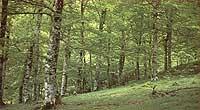
The situation of the Autonomous Community of Euskadi is unfortunate. On the one hand, it has not applied existing legislation in the State and on the other, it has not created its own legislation. In Navarre, on the contrary, state legislation has been applied and its own has been created to cover its gaps.
Situation in Navarra
The attitude of the Government of Navarra to date is noteworthy. On the one hand, he has used the possibilities granted to him by state law and, on the other, he has enacted his own foral laws to complete them.
As a consequence of the application of the first, since 1984 the Señorío de Bértiz is the Natural Park, comprising 2000 Has.
On the other hand, the Foral Law of Urban Rules of Use and Protection of the Territory develops certain aspects not covered by state legislation. This Foral Law classifies protected areas on four levels: Integral Reserves, Natural Reserves, Natural Settlements and Natural Areas of Recreation. The first has the highest level of protection and the last the lowest.
Under this Law there are currently 3 Total Reserves and 38 Natural Reserves in Navarra. Total Reserves are located in Isaba (Ukerdi and Aztaparreta) and Ochagavía (Lizardoia). 38 Among the Nature Reserves are the Pitillas Lakes, the Foces de Arbaiun and Lumbier, Olleta and Putxerri.
The 41 areas protected by Navarra law seem to be many. However, it is not much if we look at the total surface they occupy: 9 500 Ha, which accounts for 1% of the area of Navarre. If we compare this area with the protected area in the State (0.39%) and the European average (0.62%), it is observed that it is quite greater. However, in our view, this surface is not sufficient and should be extended to the maximum possible extent.
Situation in the Autonomous Community
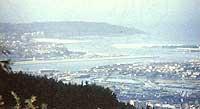
We leave the situation in Navarra to see what is the situation of protection of the Autonomous Community. Without much analysis we will realize how unfortunate the three provinces are. The Alaveses, Vizcaínos and Guipuzcoa should be embarrassed at the helplessness of our environment. State legislation has not been applied and has not been enacted by the Basque Government. In the Autonomous Community it can be said that there is no sufficiently protected environment. On the one hand are the Hunting Shelters and the Hunting Vedas. The only protection measure in these areas is the non-practice of hunting or its realization in special conditions. On the other hand, there are some Regional Parks. Its main objective is the organization of special spaces in which man can come into contact with nature, limiting the places of leisure of the people.
In the Autonomous Community, we wanted to advance along the path undertaken in Navarre and for that purpose we designed in the Ministry of the Environment a LOTURA (Law of Spatial Planning and Urbanism). This bill was forwarded to the Legislative Assembly for discussion in it, but was withdrawn from Lege-Bitzar when the new coalition government was established in March 1987. The intention, in our opinion, has been meritorious, like the cough of the goat.
The environment of the Autonomous Community is not protected. Moreover, we would say that there is a total lack of protection and if protection measures are not adopted sooner than shortly, our heirs will receive a degraded natural heritage.
Conclusion
Without a doubt, in order for natural spaces to remain in their natural state, protective measures must be adopted and extensive territories declared to a greater or lesser extent. However, all efforts made in this way may be banal if no other accompanying measures are taken. The important thing is to educate society in love and respect for nature. The protection of wide territories is a useless task if society is not aware of its meanings, functions and obligations. We would like protected areas to be like virgin islands in the sea of barbarism and catastrophe. Protected spaces are an image of respect for nature, but respect should not be limited to them. What would it do, for example, for the protected river to be clean enough for otters to live if the river could not keep life out of that area?
Basque society, unfortunately and unfortunately, is not educated in the love of nature and although it is regrettable, we must recognize that it is so. In our country they become perverse nonsense and the responsibility is for everyone. In large part it is that of the authorities we have chosen, because they do not take the appropriate measures on the one hand and because they do not show much will on the other. But elsewhere it is ours, because our actions prove it. How many are, for example, those who consider themselves naturalists and come to the mountain: those who deposit their waste?

Gai honi buruzko eduki gehiago
Elhuyarrek garatutako teknologia



